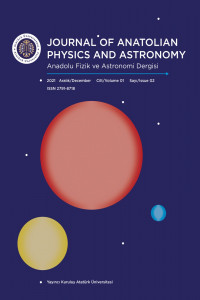BİYOLOJİK HEDEFLER İÇİN Dmax DEĞERLERİNİN DURDURMA GÜCÜNE BAĞIMLILIĞI
In this study, the relationship between stopping power and dmax values in the interaction of electrons with brain, breast and eye tissues is discussed. Stopping power values were obtained by using Roothaan-Hartree-Fock electronic charge densities, while dmax values obtained with Monte Carlo based computer code Electron Gamma Shower (EGSnrc). A linear relationship between stopping power and dmax values has been observed; and a function was obtained that connects the dmax values to the stopping power values by the curve fitting method. Thus, dmax values can be obtained easily from stopping power values for various energy values.
Anahtar Kelimeler:
Doz, Durdurma Gücü, Elektron, EGSnrc, Biyolojik Dokular
STOPPING POWER DEPENDENCE of Dmax VALUES for BIOLOGICAL TARGETS
In this study, the relationship between stopping power and dmax values in the interaction of electrons with brain, breast and eye tissues is discussed. Stopping power values were obtained by using Roothaan-Hartree-Fock electronic charge densities, while dmax values obtained with Monte Carlo based computer code Electron Gamma Shower (EGSnrc). A linear relationship between stopping power and dmax values has been observed; and a function was obtained that connects the dmax values to the stopping power values by the curve fitting method. Thus, dmax values can be obtained easily from stopping power values for various energy values.
Keywords:
Dose, Stopping Power, Electron, EGSnrc, Biological Tissues,
___
- [1] H. Nikjoo, S. Uehara, D. Emfietzoglou, Interaction of radiation with matter, CRC press2012.
- [2] L. Wang, C.S. Chui, M. Lovelock, A patient‐specific Monte Carlo dose‐calculation method for photon beams, Medical physics 25(6) (1998) 867-878.
- 3] R.L. Ford, W.R. Nelson, The EGScode system, Preprint SLAC-210(1978).
- [4] M.Ç. Tufan, T. Namdar, H. Gümüş, Stopping power and CSDA range calculations for incident electrons and positrons in breast and brain tissues, Radiation and environmental biophysics 52(2) (2013) 245-253.
- [5] I. Lebedenko, S. Khromov, T. Bondarenko, E. Chertenkov, Calculation of the Radiation Dose Absorbed by Human Biological Tissue When Using Imaging Equipment in Radiotherapy, MeasurementTechniques (2021) 1-4.
- [6] P. Björk, T. Knöös, P. Nilsson, Influence of initial electron beam characteristics on Monte Carlo calculated absorbed dose distributions for linear accelerator electron beams, Physics in Medicine & Biology 47(22) (2002) 4019.
- [7]H. Al Kanti, O. El Hajjaji, T. El Bardouni, M. Mohammed, An analytical fit and EGSnrc code (MC) calculations of personal dose equivalent conversion coefficients for mono-energetic electrons, Applied Radiation and Isotopes 154 (2019) 108906.
- [8] Z. Yüksel, M.Ç. Tufan, Relationship between dose and stopping power values for electrons in skin and muscle tissues, Radiation and Environmental Biophysics 60(1) (2021) 135-140.
- [9] Z. Yüksel, M.Ç. Tufan, Estimating the effect of electron beam interactions with biological tissues, Canadian Journal of Physics 96(12) (2018) 1338-1348.
- [10] E.B. Podgorsak, Radiation oncology physics, Vienna: International Atomic Energy Agency (2005) 123-271.
- [11] F.M. Khan, J.P. Gibbons, Khan's the physics of radiation therapy, Lippincott Williams & Wilkins2014.
- [12] K.R. Hogstrom, P.R. Almond, Review of electron beamtherapy physics, Physics in Medicine & Biology 51(13) (2006) R455.
- [13] W. Snyder, M. Cook, E. Nasset, L. Karhausen, G.P. Howells, I. Tipton, Report of the task group on reference man, Pergamon Oxford1975.
- [14] I. ICRU, Tissue substitutes in radiation dosimetry and measurement, International Commission on Radiation Units and Measurements (1989).
- [15] S.M. Seltzer, M.J. Berger, Evaluation of the collision stopping power of elements and compounds for electrons and positrons, The International Journal of Applied Radiation and Isotopes 33(11) (1982) 1189-1218.
- [16] D.C. Montgomery, E.A. Peck, G.G. Vining, Introduction to linear regression analysis, John Wiley & Sons2021.
- [17] K. Wakabayashi, H. Monzen, M. Tamura, K. Matsumoto, Y. Takei, Y. Nishimura, Dosimetric evaluation of skin collimation with tungsten rubber for electron radiotherapy: A Monte Carlo study, Journal of Applied Clinical Medical Physics 22(4) (2021) 63-70.
- [18] Y. Liang, W. Muhammad, G.R. Hart, B.J. Nartowt, Z.J. Chen, B.Y. James, K.B. Roberts, J.S. Duncan, J. Deng, A general-purpose Monte Carlo particle transport code based on inverse transform sampling for radiotherapy dose calculation, Scientific reports 10(1) (2020) 1-18.
- [19] C.-M. Ma, S.B. Jiang, Monte Carlo modelling of electron beams from medical accelerators,Physics in Medicine & Biology 44(12) (1999) R157.
- [20] I.J. Das, K.P. McGee, C.W. Cheng, Electron‐beam characteristics at extended treatment distances, Medical physics 22(10) (1995) 1667-1674.
- [21] S. Lashkari, H.R. Baghani, M.B. Tavakoli, S.R. Mahdavi, An inter-comparison between accuracy of EGSnrc and MCNPX Monte Carlo codes in dosimetric characterization of intraoperative electron beam, Computers in Biology and Medicine 128(2021) 104113.
- [22] F.M. Khan, K.P. Doppke, K.R. Hogstrom, G.J. Kutcher, R. Nath, S.C. Prasad, J.A. Purdy, M. Rozenfeld, B.L. Werner, Clinical electron‐beam dosimetry: report of AAPM radiation therapy committeetask group No. 25, Medical physics 18(1) (1991) 73-109.
- [23] J. Laughlin, J. Beattie, Ranges of high energy electrons in water, Physical Review 83(3) (1951) 692.
- [24] B. Kirkwood, J. Sterne, Bootstrapping. Medical Statistics, Oxford: Blackwell Science, 2003.
- Başlangıç: 2021
- Yayıncı: Atatürk Üniversitesi
Sayıdaki Diğer Makaleler
BİYOLOJİK HEDEFLER İÇİN Dmax DEĞERLERİNİN DURDURMA GÜCÜNE BAĞIMLILIĞI
Zeynep YÜKSEL, M. Çağatay TUFAN
ATA50 TELESKOBU İLE GÖK CİSİMLERİNİN IŞIK ÖLÇÜM GÖZLEMLERİ
Cihan Tuğrul TEZCAN, Fatma TEZCAN, Recep BALBAY, Cahit YEŞİLYAPRAK
BRIDGMAN/STOCKBARGER TEKNİĞİYLE BÜYÜTÜLEN XIIIn2Se4 ÜÇLÜ YARIİLETKENLERİN YAPISAL KARAKTERİZASYONU
Bekir GÜRBULAK, Kübra ALEMDAR DUMAN, Mehmet Kürşat DUMANLI
Esra KAVAZ, Fatime GEYİKOĞLU, Neslihan EKİNCİ
ÇEVRESEL ŞARTLARIN TAKİBİNİ YAPAN ÖLÇER SİSTEMİ GELİŞTİRİLMESİ
Recep BALBAY, Cihan Tuğrul TEZCAN, Onur ŞATIR, Cahit YEŞİLYAPRAK
